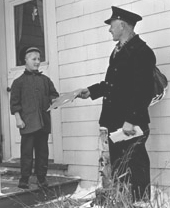Correspondence Education
 Elementary courses by correspondence were first offered by the
Education Department in 1919 when John Kyle, Organizer of the
Technical Education Branch, provided notes and textbooks to 86
children living in isolated parts of the province. Thirteen of
the children lived in lighthouses, and Kyle afterwards noted that
"this unique educational step has been the means of bringing
a note of pleasure and profit into their otherwise lonely lives."
British Columbia was the first province in Canada to offer such
courses.
Elementary courses by correspondence were first offered by the
Education Department in 1919 when John Kyle, Organizer of the
Technical Education Branch, provided notes and textbooks to 86
children living in isolated parts of the province. Thirteen of
the children lived in lighthouses, and Kyle afterwards noted that
"this unique educational step has been the means of bringing
a note of pleasure and profit into their otherwise lonely lives."
British Columbia was the first province in Canada to offer such
courses.
The popularity of the courses prompted the Education Department to establish its "Elementary Correspondence School." During its first decade, the school was the responsibility of the Technical Education Branch. After 1929, following an amendment of the Public School Act, it became a separate branch of the department. By that time, the Elementary Correspondence School Branch was providing courses to over 600 pupils.
James Hargreaves was Officer-in-Charge (i. e. the director) of the branch from 1919 to 1933. (Hargreaves had previously been an instructor for the Coal Mining Correspondence courses which had been established by the Education department in conjunction with the Department of Mines in 1917. Hargreaves was succeeded by Isabel Bescoby (1934-1937), Anna B Miller (1937-1950) [Anna B. Walsh, 1951], and Major A. H. Plows (1952-1968).
Initially, the Elementary Correspondence School catered only to children in isolated areas-those living more than three miles beyond an established school district. Later, its programmes broadened to include disabled children who were unable to attend regular schools, under-educated adults, and new immigrants who wished to learn English.
During the Depression, the Elementary Correspondence branch provided courses to unemployed men in federal government relief camps, and during the Second World War it provided education to Japanese children who had been interned by another federal government agency, the British Columbia Security Commission. In 1941, a regional office was opened in Pouce Coupe for elementary correspondence students in the Peace River region.
High school correspondence courses commenced in 1929. Again, British Columbia was the first province to provide such instruction. In addition to providing high school courses to students in remote areas, the High School Correspondence Branch provided supplementary material to students attending small high schools that offered only a limited range of programmes. The branch also offered technical and vocational courses.
John Wesley Gibson, formerly director of Elementary Agricultural Education, was the first Officer-in-Charge of the branch, a position he held until his retirement in 1940. Gibson was succeeded by Dr. Edith E. Lucas (1941-1963) and J. Ross Hind (1963-1978).
In 1966, the High School Correspondence Branch was renamed the Secondary School Correspondence Branch. In 1968, it was amalgamated with the Elementary Correspondence Branch to form the Correspondence Education Branch, under the direction of J. Ross Hind.
The mandate of the new branch was explained in the 98th Public Schools Report (1968/69), p. G38: "In this field [correspondence education], in which British Columbia was a pioneer, needs have changed over the years. The original purpose, that of bringing education to children in isolated areas, still exists, but the expansion of population and of greater school facilities has reduced the number of children needing this service. Correspondence education now tends to supplement and expand curriculum offerings available to children in smaller schools, to extend to the adult population to a greater degree, to assist the child temporarily homebound through illness and accident, and to assist industry with special vocational courses. The new organization is designed to recognize the continuous nature of learning and to facilitate it by reducing emphasis on its segmentation."
Hind retired in 1978 and was succeeded as branch director by W. B. Naylor. Hind subsequently helped to establish the Open Learning Institute. The new institute was set up to facilitate the development and delivery of distance education in adult basic education, career/technical/vocational programmes, and university credit courses. The Open Learning Institute drew on the expertise of the Correspondence Education Branch and was enhanced with resources from the Provincial Education Media Centre [1972]. In 1988 the Open Learning Institute merged with the Knowledge Network [1979] to form the Open Learning Agency.
In the 1980s the term "correspondence education" was supplanted by "distance education" - a change that reflected the growth of the World Wide Web and the advent of online, Internet-based resources. In 1995 the Ministry of Education established a new policy for Distance Education. As a result, the responsibility for overseeing students enrolled in distance education and "electronic education" courses was transferred from the ministry in Victoria to the school districts were students resided. Course materials were provided by the Open School. Established in 1998 as a division of Open Learning Agency (OLA), the Open School offered K-12 courses, resources, and teacher development under contract for the Ministry of Education. The ministry's contract with OLA ended on 31 March 2003. Afterwards, school districts "wishing to use, modify or sell the course material previously held at Open School" were required to sign a license agreement with the province.
Current [2004] policies regarding distance education and online learning in British Columbia are described on the BC Ministry of Education web site, on a page entitled Distance Education Opportunities.
Source:
Patrick A. Dunae, The School Record (Victoria: British Columbia Archives and Records Service, 1992), p. 73; Belle C. Gibson, Teacher-Builder: The Life and Work of J. W. Gibson (Victoria: privately printed, 1961), pp. 101 - 109.

